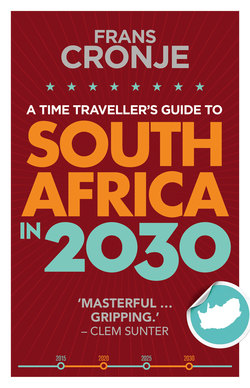Читать книгу A Time Traveller's Guide to South Africa in 2030 - Frans Cronje - Страница 4
На сайте Литреса книга снята с продажи.
Foreword
ОглавлениеNobody can predict precisely the way the future is going to play out in the long term. That is why it is much better to be vaguely right than precisely wrong. Scenario planning is a methodology that accepts this principle by identifying the forces or trends that are shaping the future, choosing the ones that are likely to have the most impact, constructing scenarios that illustrate the possible causal chains flowing from those forces or trends, and deciding on the ‘flags’ that will give a feel for which scenario is likely to materialise during the period under review.
In his second book, Frans Cronje has used the technique in a masterful manner to examine the plausible scenarios for South Africa to 2030. He feels this is an appropriate moment to do so as South Africa has entered the period of the Fourth Transition, the previous ones being in 1910, 1948 and 1994. He points to all the good things that have happened since 1994 under the new dispensation, but shows convincingly that we face unprecedented economic challenges as a result of the poor performance displayed by the South African economy since 2007.
In short, South Africa is at a tipping point where small random events can have a major effect on the system as a whole because of all the feedback loops contained in the system reinforcing one another and producing extreme results. In the world at large, we had two remarkable examples of this phenomenon in 2016 in the unexpected decision by Britain to leave the European Union after a referendum there, and the election of Donald Trump as the next American President when the polls were completely against him winning. Indeed, Frans begins his book with the story of how the decision of a young man named Mohamed Bouazizi to set himself alight in Tunisia in December 2010 had massive consequences for the Middle East as a whole.
Here in South Africa we have the growing frustrations of young people who have no prospect of improving their lives as the potential spark for economic and political destabilisation. Bouazizi felt exactly the same way before he died. It is therefore no surprise that Frans and his team have chosen whether popular expectations are met or remain unmet as one of the axes of the scenario matrix providing the four possible scenarios of South Africa’s future to 2030. The other axis is whether the state will be dominant or weak.
The four scenarios, which all make for gripping reading, are then described in the following order. ‘The Rise of the Right’ scenario depicts a new model of authoritarian capitalism that sees the erosion of democratic rights and freedoms, but on the other hand a great improvement in the material conditions of almost all South Africans. This promotes a new sense of common purpose and cohesion among citizenry and propels South Africa once again to being Africa’s leading economy, with its success being heralded across the emerging world. Similarities with the recent evolution of China, South Korea and Singapore come to mind.
In the second scenario, called ‘The Tyranny of the Left’, stagnant and negative economic growth rates persist with the state pursuing reckless out-of-date socialist policies that lead to a series of ratings downgrades and major capital flight. Inflation, debt and interest rates soar, causing widespread dejection among the public, who remain cowed and resigned to their fate. The difference between Russia and China’s economic trajectory since 1978 illustrates the parting of the ways between the first and second scenarios.
The third scenario, ‘The Break-up of South Africa’, portrays a weak and divided government in which fragmentation, factionalism and confusion reign. Two classes of South Africans become apparent: the one within the walls, and the one outside the walls. They have very little to do with each other. Race as well as ethnic divisions deepen and it is unclear whether society will ever be put back together again.
The fourth and last scenario is undoubtedly the most positive one and is aptly titled ‘Rise of the Rainbow’. South Africa is no longer the country in which people wait for the government to do something for them. It is one in which they will do it for themselves, and the government is there to help create the conditions for them to do so. Rather than weak government, this scenario describes the type of leadership in government that Nelson Mandela once fondly described as leading a flock of sheep from behind. South Africa, with a booming middle class, becomes an Asian Tiger without the authoritarianism inherent in ‘The Rise of the Right’ scenario. The rebound in the economy means that South Africans emerge from their self-imposed enclaves and live comfortably alongside one another.
Story-telling is an art that engages the emotions as well as the intellect. I sincerely hope that these scenarios enter the common vocabulary in South Africa in the same way that the ‘High Road/Low Road’ scenarios did in the mid-1980s. They should, because the narrative is very persuasive and has the capacity to inspire people to take the actions necessary to fulfil this country’s extraordinary potential.
CLEM SUNTER
